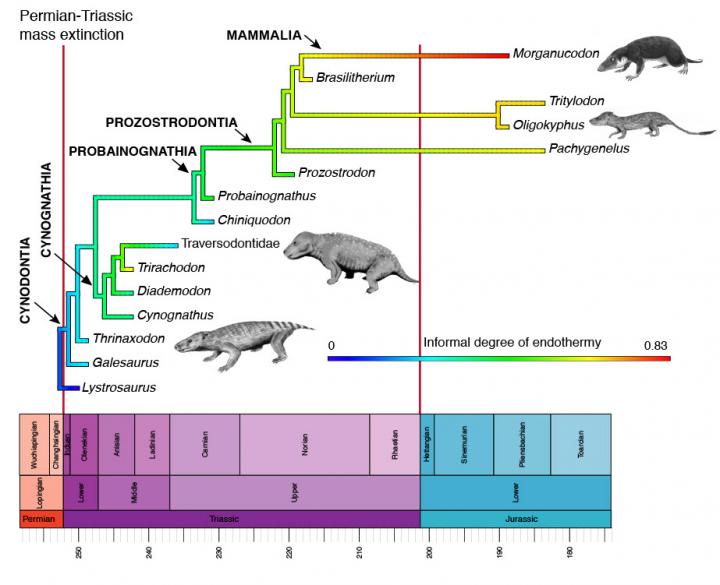
Credit: Credit: Mike Benton, University of Bristol. Animal images are by Nobu Tamura, Wikimedia.
Mammals and birds today are warm-blooded, and this is often taken as the reason for their great success.
University of Bristol palaeontologist Professor Mike Benton, identifies in the journal Gondwana Research that the ancestors of both mammals and birds became warm-blooded at the same time, some 250 million years ago, in the time when life was recovering from the greatest mass extinction of all time.
The Permian-Triassic mass extinction killed as much as 95 per cent of life, and the very few survivors faced a turbulent world, repeatedly hit by global warming and ocean acidification crises. Two main groups of tetrapods survived, the synapsids and archosaurs, including ancestors of mammals and birds respectively.
Palaeontologists had identified indications of warm-bloodedness, or technically endothermy, in these Triassic survivors, including evidence for a diaphragm and possible whiskers in the synapsids.
More recently, similar evidence for early origin of feathers in dinosaur and bird ancestors has come to light. In both synapsids and archosaurs of the Triassic, the bone structure shows characteristics of warm-bloodedness.
The evidence that mammal ancestors had hair from the beginning of the Triassic has been suspected for a long time, but the suggestion that archosaurs had feathers from 250 million years ago is new.
But a strong hint for this sudden origin of warm-bloodedness in both synapsids and archosaurs at exactly the time of the Permian-Triassic mass extinction was found in 2009. Tai Kubo, then a student studying the Masters in Palaeobiology degree at Bristol and Professor Benton identified that all medium-sized and large tetrapods switched from sprawling to erect posture right at the Permian-Triassic boundary.
Their study was based on fossilised footprints. They looked at a sample of hundreds of fossil trackways, and Kubo and Benton were surprised to see the posture shift happened instantly, not strung out over tens of millions of years, as had been suggested. It also happened in all groups, not just the mammal ancestors or bird ancestors.
Professor Benton said: “Modern amphibians and reptiles are sprawlers, holding their limbs partly sideways.
“Birds and mammals have erect postures, with the limbs immediately below their bodies. This allows them to run faster, and especially further. There are great advantages in erect posture and warm-bloodedness, but the cost is that endotherms have to eat much more than cold-blooded animals just to fuel their inner temperature control.”
The evidence from posture change and from early origin of hair and feathers, all happening at the same time, suggested this was the beginning of a kind of ‘arms race’. In ecology, arms races occur when predators and prey have to compete with each other, and where there may be an escalation of adaptations. The lion evolves to run faster, but the wildebeest also evolves to run faster or twist and turn to escape.
Something like this happened in the Triassic, from 250 to 200 million years ago. Today, warm-blooded animals can live all over the Earth, even in cold areas, and they remain active at night. They also show intensive parental care, feeding their babies and teaching them complex and smart behaviour. These adaptations gave birds and mammals the edge over amphibians and reptiles and in the present cool world allowed them to dominate in more parts of the world.
Professor Benton added: “The Triassic was a remarkable time in the history of life on Earth. You see birds and mammals everywhere on land today, whereas amphibians and reptiles are often quite hidden.
“This revolution in ecosystems was triggered by the independent origins of endothermy in birds and mammals, but until recently we didn’t realise that these two events might have been coordinated.
“That happened because only a tiny number of species survived the Permian-Triassic mass extinction – who survived depended on intense competition in a tough world. Because a few of the survivors were already endothermic in a primitive way, all the others had to become endothermic to survive in the new fast-paced world.”
###
Paper:
‘The origin of endothermy in synapsids and archosaurs and arms races in the Triassic’ by M. J. Benton in Gondwana Research
Media Contact
Mike Benton
[email protected]




